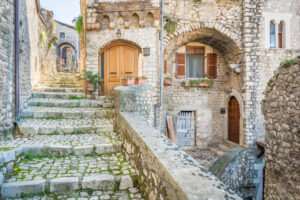Ninfa Garden’s, Sermoneta Village and Valvisciolo Abbey
(1,30 hours drive from Rome)
Sermoneta
The hill town of Sermoneta is situated within the Province of Latina, a distance of 83 kilometres south east of Rome, the regional capital of Lazio. Standing at an elevation of 257 metres above sea level it has a population of around 10,000 residents.
Sermoneta is a captivating hilltop town located in the region of Lazio, Italy. Situated in the province of Latina, this medieval gem offers visitors a journey back in time with its well-preserved historical architecture, ancient walls, and scenic views of the surrounding countryside.
Sermoneta has ancient origins, dating back to Roman times when it was known as “Caetra.” During the Middle Ages, the town developed as a fortified center, and its strategic hilltop location made it an important defensive stronghold. Over the centuries, Sermoneta was ruled by various noble families, including the Caetani and the Colonna.
The town’s historical heritage is evident in its medieval walls, narrow alleys, and historical buildings. Today, Sermoneta is known for its historical charm, architectural richness, and breathtaking panoramas.
Nearby places of interest include the Garden of Ninfa:
If you’re looking for a magical and off the beaten path place to visit during your Italian holiday, the Garden of Ninfa is the place for you. Often dubbed the most romantic garden in the world, this place feels like a faraway land of enchantment. The Ninfa Garden Italy (and the village it takes its name from) is located 64 km southeast of Rome, at the base of the Lepini Mountains. Its balance of nature made the Lazio Region declare it a Natural Monument. Besides being the perfect day trip for couples, it’s also a great resting place when traveling between Rome and Naples. Because of its lovely lakes, colorful vegetation and beautiful medieval ruins, Ninfa Garden is no less than a dreamy place to visit.
Back in the Roman era, in the current village of Ninfa stood a temple dedicated to the goddesses of spring water, the Naiad Nymphs. Back in those days, Romans believed that nymphs dwelled by springs and rivers, hidden in groves and grottoes. And there’s plenty of that to go around in the Giardino di Ninfa!
Fast forward a couple of millennia, and the area has retained its name, though not much is left from that time. Today’s Ninfa Garden mainly consists of flowers and plants that grow abundantly on the medieval ruins of the village.
The village of Ninfa was founded during the Roman times, and it was a rich town in the early centuries of the Middle Ages. A lot happened during the 12th century, as Pope Alexander III was crowned there and decades later the Holy Roman Emperor Frederick Barbarossa sacked and burned it down. Still, the town bloomed again with over 100 homes, a few churches, mills, bridges, a town hall and a castle. Huge guard towers stood outside the gates, protecting the village. However, it was later destroyed in the 14th century.
Valvisciolo Abbey
THE BEAUTIFUL ABBEY OF VALVISCIOLO (from the Italian “Valle dell’Usignolo”, Valley of the Nightingale) can be found between the gardens of Ninfa and the medieval town of Sermoneta, set against a backdrop of central Italy’s Lepini mountains.
Though we know very little about the earliest history of the abbey, it dates back to at least the 12th century, if not earlier. It was founded by Greek Basilian monks, and supposedly occupied by the Knights Templar in the 13th century. Legend has it that the Church’s architraves broke when the Templar Grand Master, Jacques de Molay, was burnt at the stake in 1314 (the Order had been suppressed and its members persecuted).
Traces of the abbey’s Templar past are believed to be subtle but very significant. A small templar cross is carved on the rose window on the façade, and the crack in the architrave is visible just underneath. More templar crosses have been spotted inside the church and on the ceilings of the cloister.
But one of the the abbey’s most interesting features is a very small carving on the wall that you walk past to enter the cloister. Sheltered by a transparent screen, you will find an unusual palindromic SATOR inscription. Its shape is not square, like those found elsewhere, but instead five concentric circles, crossed by five lines that divide the circles into five sectors that contain five letters. The palindrome is read in the following way in any direction: Sator Arepo Tenet Opera Rotas. The exact meaning of the inscription is unclear.
If you look carefully, you might also spot several carvings of Solomon’s knot (which has been interpreted as a metaphor of one’s esoteric journey in search of the self and of truth) and of the omphalos, the sacred center of the world. All of these carvings were discovered during restorations of the cloister and they might provide a mysterious testimony of the presence of the Knights Templar and of their spiritual symbolism.
Today, the Romanesque-Cistercian style abbey is home to Cistercian monks. The church has three naves divided by pillars and columns and bare walls, as the Cistercian tradition that avoids architectural splendor to emphasize the importance of the spiritual over the material.
Duration: 10 hours













